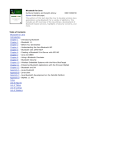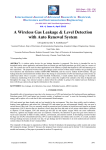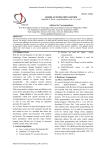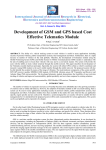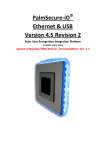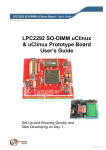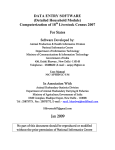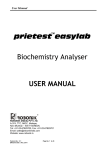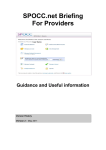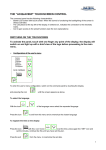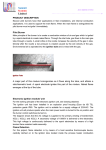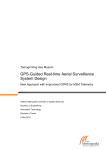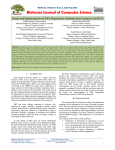Download Agricultural Field Monitoring System Using ARM
Transcript
ISSN (Print) : 2320 – 3765 ISSN (Online): 2278 – 8875 International Journal of Advanced Research in Electrical, Electronics and Instrumentation Engineering (An ISO 3297: 2007 Certified Organization) Vol. 3, Issue 4, April 2014 Agricultural Field Monitoring System Using ARM Shweta S. Patil1, Ashwini V. Malviya2 PG student, Department of Electronics And Telecommunication, SIPNA’S College of Engineering And Technology, Amravati (M.S.), India 1 Assistant Professor, Department of Electronics And Telecommunication, SIPNA’S College of Engineering And Technology, Amravati (M.S.), India 2 ABSTRACT: The paper ”AGRICULTURAL FIELD MONITORING SYSTEM USING ARM” comprises of ARM7TDMI core processor , zigbee module, GSM modem. It shows the results of sensors in the agricultural field using zigbee. The system mainly attains the importance in modernising the agricultural environment to overcome the traditional farming. The field is monitored using , different sensors that sense the field parameters like temperature, humidity, soil moisture, water level of well and also 3-ɸ supply in the farm. All these field conditions are checked and in case of extreme conditions the SMS is sent to farmer mobile number. The sensors sense the parameters and send them to processors after which it is sent to zigbee module and from zigbee module it is send to the farmer mobile using GSM SIM900 module. The farmer also gets display on the spot in the farm in the form of LCD display about the field parameters and it continuously shows the display and sends SMS if field needs a care. KEYWORDS: Agricultural field, ARM, GSM SIM900 module, zigbee, sensors. I.INTRODUCTION The paper “AGRICULTURAL FIELD MONITORING SYSTEM USING ARM” mainly focuses on modernising the agricultural monitoring procedure. The agricultural activities comprise of field watering, checking water level of well, motor on-off time, rainfall in the field, sunlight in the field etc. All these activities are monitored with the help of ARM controller. These conditions are sensed with the help of respective sensors like temperature sensor, humidity sensor, soil moisture sensors etc, and also 3- ɸ supply checker to check the load shedding conditions. In our system, we are basically concentrating on following applications: To check wet and dry conditions of the soil . To check the high and low water level of well. To check the dew point content, humidity so as to forecast the weather condition. To check the temperature of the field. It gives the information about the field condition to the user through SMS in case of extreme conditions. ARM7TDMI, GSM and ZIGBEE form the heart of the system. All the sensors sense their respective values and given from arm controller to zigbee module of transmitter and through wireless communication to receivers zigbee and arm controller of receiver will send the data to GSM modem and using AT commands this data is sent on user’s mobile number in case of extreme condition that exceed the threshold values. The specific threshold values of temperature and humidity are feed to the ARM controller in the form of program. As soon as the atmospheric temperature and humidity exceed this threshold values receiver sends command to the GSM module , activated GSM SIM900 module will send this message to the number saved in database. The system also gives the response if one of the 3- ɸ is OFF, which may be helpful in checking the load-shedding conditions in order to water the crop. The system gives the LCD display about the current temperature and humidity values in the farm and can be checked any time. LCD display can be checked at the transmitter as well as receiver side. This system also shows the current situation about the soil whether it is DRY or WET. The farmer may consider this as a alarm for watering the field, the moisture content of the soil is checked from this sensor. Copyright to IJAREEIE www.ijareeie.com 8781 ISSN (Print) : 2320 – 3765 ISSN (Online): 2278 – 8875 International Journal of Advanced Research in Electrical, Electronics and Instrumentation Engineering (An ISO 3297: 2007 Certified Organization) Vol. 3, Issue 4, April 2014 GSM TECHNOLOGY GSM (Global System for Mobile communication) is a digital mobile telephone system that is widely used in many parts of the world. It uses a variation of Time Division Multiple Access (TDMA) and is the most widely used of the three digital wireless telephone technologies (TDMA, GSM, and CDMA). GSM digitizes and compresses data, then sends it down a channel with two other streams of user data, in its own time slot each. GSM operates in the 900MHz, 1800MHz, or 1900 MHz frequency range Mobile Subscriber ISDN Number (MSISDN) Call Routing Fig: Mobile Subscriber ISDN Number (MSISDN) Call Routing When a user dials a GSM mobile subscriber's MSISDN, the PSTN routes the call to the Home MSC based on the dialed telephone number. The MSC must then query the HLR based on the MSISDN, to attain routing information required to route the call to the subscribers' current location. The MSC stores global title translation tables that are used to determine the HLR associated with the MSISDN. When only one HLR exists, the translation tables are trivial. When more than one HLR is used however, the translations become extremely challenging; with one translation record per subscriber (see the example above). Having determined the appropriate HLR address, the MSC sends a Routing Information Request to it. When the HLR receives the Routing Information Request, it maps the MSISDN to the IMSI, and ascertains the subscribers' profile including the current VLR at which the subscriber is registered. The HLR then queries the VLR for a Mobile Station Roaming Number (MSRN). The MSRN is essentially an ISDN telephone number at which the mobile subscriber can currently be reached. The MSRN is a temporary number that is valid only for the duration of a single call. The HLR generates a response message, which includes the MSRN, and sends it back across the SS7 network to the MSC. Finally, the MSC attempts to complete the call using the MSRN provided ZIGBEE TECHNOLOGY The system uses zigbee technology, Zigbee is a low power wireless sensor network used in many applications such as oil field monitoring, industrial monitoring, mine safety etc.. But the usage of zigbee wireless sensor network in agricultural field is very low. This paper shows the model for perfect monitoring of crop field and experimental result of that model when deploying nodes in real time. Physical and MAC (Medium Access Control) layers of zigbee are supported by IEEE 802.15.4. The physical layer supports three frequency bands that are 2.450MHz, 915MHz and 868 MHz with different gross data rates (250 kbs-1), (40 kbs-1) and (20 kbs-1) respectively. Table shows the features of the IEEE 802.11b, BLUETOOTH and ZIGBEE with their comparative features. Copyright to IJAREEIE www.ijareeie.com 8782 ISSN (Print) : 2320 – 3765 ISSN (Online): 2278 – 8875 International Journal of Advanced Research in Electrical, Electronics and Instrumentation Engineering (An ISO 3297: 2007 Certified Organization) Vol. 3, Issue 4, April 2014 II. LITERATURE SURVEY [8]In this paper we have discussed about how to utilize the sensor in the paddy crop field area and gives proposed architecture for real time paddy crop field monitoring with zigbee wireless sensor network analysed about real time readings of temperature and humidity sensor deployed in real time. Result shows that zigbee wireless sensor network is efficient for paddy crop field monitoring. Now we are working in the part how to resend the packets when packet loss occurs and also doing simulation work for more number of nodes implementing in the paddy crop field environment. The proposed work gives efficient monitoring of paddy crop field monitoring. [9]The project is thus carried out using ARM7TDMI core with the help of GSM technologies. This project finds application in domestic agricultural field. In civilian domain, this can be used to ensure faithful irrigation of farm field, since we have the option of finding out moisture level of soil in a particular area [10] The article based on embedded database of greenhouse temperature and humidity control system intelligent. Put forward by embedded database system set up in an ideal environment for data greenhouse temperature and humidity control, greenhouse crops in the process of growth under control. [11] The purpose of this paper is to provide a review of a range of popular sensors on the market. The paper also discusses their operating principles as well as addresses their advantages and disadvantages. [12] This project implements the emerging applications of GSM technology. Using GSM networks, a control system has been proposed that will act as an embedded system which can monitor and control an agricultural motor and other devices locally using built-in input and output peripherals. . III.SYSTEM MODEL AND DESCRIPTION This system used to improve the irrigation system of Indian agriculture & provide with adequate irrigation. This project will use ARM7 TDMI-S based NXP’s (national semiconductors and Philips) LPC 2148 microcontroller in LQFP (Low profile Quad Flat package) with 64 pins. The Power requirement of LPC2148 Microcontroller is 3.3VDC and VSS ground. The power supply for the LPC2148 is produced by using available 1 Φ 230VAC with the help of conversion AC to DC supply which includes four most basic steps of step down the available power to required level of power supply, Rectification of 1Φ supply to the pulsated DC supply, filtering of Pulsated DC supply to non regulated DC supply and then through regulator a pure regulated DC supply is produced. This project consist of microcontroller LPC2148, GSM module, temperature sensor, humidity sensor, water level sensor, soil moisture sensor and the Power block. Copyright to IJAREEIE www.ijareeie.com 8783 ISSN (Print) : 2320 – 3765 ISSN (Online): 2278 – 8875 International Journal of Advanced Research in Electrical, Electronics and Instrumentation Engineering (An ISO 3297: 2007 Certified Organization) Vol. 3, Issue 4, April 2014 Temperature sensor is a chip that tells you what the ambient temperature is, a humidity sensor, also called a hygrometer, that measures and regularly reports the relative humidity in the air. Soil moisture sensors measure the water content in soil. The soil moisture probe is made up of multiple soil moisture sensors. Soil moisture is highly variable. Readings from a single site isn't enough to give accuracy. In-order to make good soil moisture readings, you need research quality probes and you need a number of probes placed. The phase line sensor is the indication of the power on the three lines of the supply of 230VAC.The water level sensor senses the level of the water in the well and indicates the status of the well and displays it on the LCD Screen. Here we consider 2 levels for our indication such as low level & high level. The LCD is connected with the 4-bit mode. The four data pins (i.e. D4-D7 of the LCD) are connected to the P1.18 to P1.21 pins of the port 1. The control pin RS of the LCD is connected to the P1.16 and the chip enable pin of the LCD are connected to the P1.17 of the microcontroller. The temperature sensor is connected to the ADC pin P0.28 of the microcontroller. Humidity sensor is connected to the ADC pin P0.29 of the microcontroller. The main working of this project is to continuously check the temperature, humidity and soil moisture conditions through internal ADC and displays the readings on the LCD display. If the reading goes beyond the threshold values then the specified person will be indicated through SMS using the GSM module, which is connected to the microcontroller. Fig a) shows the picture of transmitter of our system and fig b) shows the picture of receiver of our system that is placed in the agricultural field, which will sense the respective parameters and show the values on the LCD display and process it to send SMS through GSM to the user mobile. FIG: a) transmitter Fig: b) receiver Copyright to IJAREEIE www.ijareeie.com 8784 ISSN (Print) : 2320 – 3765 ISSN (Online): 2278 – 8875 International Journal of Advanced Research in Electrical, Electronics and Instrumentation Engineering (An ISO 3297: 2007 Certified Organization) Vol. 3, Issue 4, April 2014 .IV. FLOWCHART Below figure shows the flowchart about the working of the system. Initially after setting up the network it checks all the field conditions i.e. sensors do their work of sensing the data. This sensed data is then processed by the ARM controller. Then to the ZIGBEE node of transmitter then to ZIGBEE node of the receiver and then to the GSM .If this data is above threshold value then send SMS to user. It means it will alarm the farmer that the field needs some care. And finally show that system is in condition. V. RESULT After implementation of the above system in agricultural field this system has given the results of all the sensors as under. A) Temperature sensor These readings are taken and plotted in the form of graph as shown below. This temperature will be displayed on LCD display and as soon as the reaches threshold value (e.g 50) GSM SIM900 module will send SMS to the user “TEMPERATURE HIGH”. Copyright to IJAREEIE www.ijareeie.com 8785 ISSN (Print) : 2320 – 3765 ISSN (Online): 2278 – 8875 International Journal of Advanced Research in Electrical, Electronics and Instrumentation Engineering (An ISO 3297: 2007 Certified Organization) Vol. 3, Issue 4, April 2014 S NO TEMPERATURE(˚C) TIME(s) 1 2 3 4 5 26.2 26.1 27.4 26.9 25.9 11.15 11.16 11.17 11.20 11.21 B) Humidity sensor The humidity was displayed on LCD display in the form of small values (like 0004 0006 etc.) which is converted into percentage and shown in table and plotted in the graph as shown below. As soon as this humidity crosses the threshold value, the GSM SIM900 module will send SMS to the user “HUMIDITY HIGH”. S NO HUMIDITY(%) TIME(s) 1 2 3 4 5 65 64 70 60 69 11.15 11.16 11.17 11.20 11.21 C) Phase line sensor The 3- ɸ phase supply is connected to the 3 different transformers connected each phase separately to each of them. Then passed through the phase line sensor in case of availability of phase LED will be ON corresponding to that line. In case if any phase goes out of order or during load-shedding condition corresponding LED will be OFF and GSM module will send the SMS “PHASE1 OFF” for problem in line1,”PHASE2 OFF” for problem in line2, Copyright to IJAREEIE www.ijareeie.com 8786 ISSN (Print) : 2320 – 3765 ISSN (Online): 2278 – 8875 International Journal of Advanced Research in Electrical, Electronics and Instrumentation Engineering (An ISO 3297: 2007 Certified Organization) Vol. 3, Issue 4, April 2014 or”PHASE3 OFF” for problem in line3. In case of all the three phases off the GSM will send the SMS as”3PHASES OFF”. D) Soil moisture sensor In this case two wires are taken out of the sensors which are immersed in the soil, which will check the soil moisture content, if the soil is dry the GSM will send the SMS to the user like ”SOIL IS DRY”. And after watering the field soil will become wet, GSM will send the SMS to user like “SOIL IS WET”. And also will be displayed on LCD display. E) Water level sensor This sensors checks the water level of well, here two probes are inserted in two positions of well one at high position where water level of well is full ,at which the GSM will send the message “WATER LEVEL HIGH”, other at the low level where water will show that the well is empty, in order that the motor should not run dry GSM will send the message “WATER LEVEL NIL”. The LCD will display the same in both transmitter as well as receiver side. VI.CONCLUSION In this way we see the successful implementation of the project “AGRICULTURAL FIELD MONITORING SYSTEM USING ARM” and verified the results using different sensors, which is beneficial in modernising the agricultural environment. REFERENCES [1] ARM7TDMI, Technical Reference Manual. [2] ARM, Rev. 01 – 06, February 2004. [3] GPS4beginers, Rev. A, December 2000. [4] lpc-ARM-book-srn, The Insider’s Guide to the PHILIPS ARM7 – Based Microcontrollers. [5] UM_LPC21XX_LPC22XX_2, LPC2129 User Manual, 03 May 2004. [6] AT Commands Interface Guide at Version: 004, 05 April 2002. [7] David E. Simon, An Embedded Software Primer, fifth edition, 2007. [8] K. Nirmal Kumar P.Ranjith R.Prabakaran ‘Real Time Paddy Crop Field Monitoring Using Zigbee Network’, IEEE 978-1-4244-7926-9/11/$26.00 ©2011 [9] Mahesh M. Galgalikar ‘Real-Time Automization Of Agricultural Environment for Social Modernization of Indian Agricultural System’ IEEE 978-1-4244-5586-7/10/$26.00 C 2010 [10] SUN Rong-gao, WAN Zhong, SUN De-chao ‘Based on Embedded Database Greenhouse Temperature and Humidity Intelligent Control System’ ISSN: 1109-2734 Issue 1, Volume 8, January 2009 [11]Vu Minh Quan, Gourab Sen Gupta, Subhas Mukhopadhyay ‘Review of Sensors for Greenhouse Climate Monitoring’ IEEE 978-1-4244-80647/11/$26.00 ©2011 [12 Karthik Maddipatla, Thentu Sravani, Thota Rajesh, R.S.V. Mani Krishna, J. Avinash] ‘Remote Access to Agricultural Motor through the Usage of GSM and SMS Technologies’ Vol. 1, No. 3, 2012, ISSN 2166-2924 [13] GSM SIM900 online user manual. [14] Online user manual of different sensors and ZIGBEE module. BIOGRAPHY Ms. Shweta S. Patil has completed Bachelor of Engineering in Electronics and telecommunication from Prof. Ram Meghe Institute of Technology and Research, Badnera, Amravati, INDIA and currently pursuing Master of Engineering in Digital Electronics from Sipna’s College of Engineering and Technology, Amravati, Maharashtra, INDIA. Mrs. Ashwini V. Malviya is currently working as Assistant Professor in Electronics and Telecommunication Engineering Department, Sipna’s College of Engineering, Amravati, Maharashtra, INDIA. Copyright to IJAREEIE www.ijareeie.com 8787







